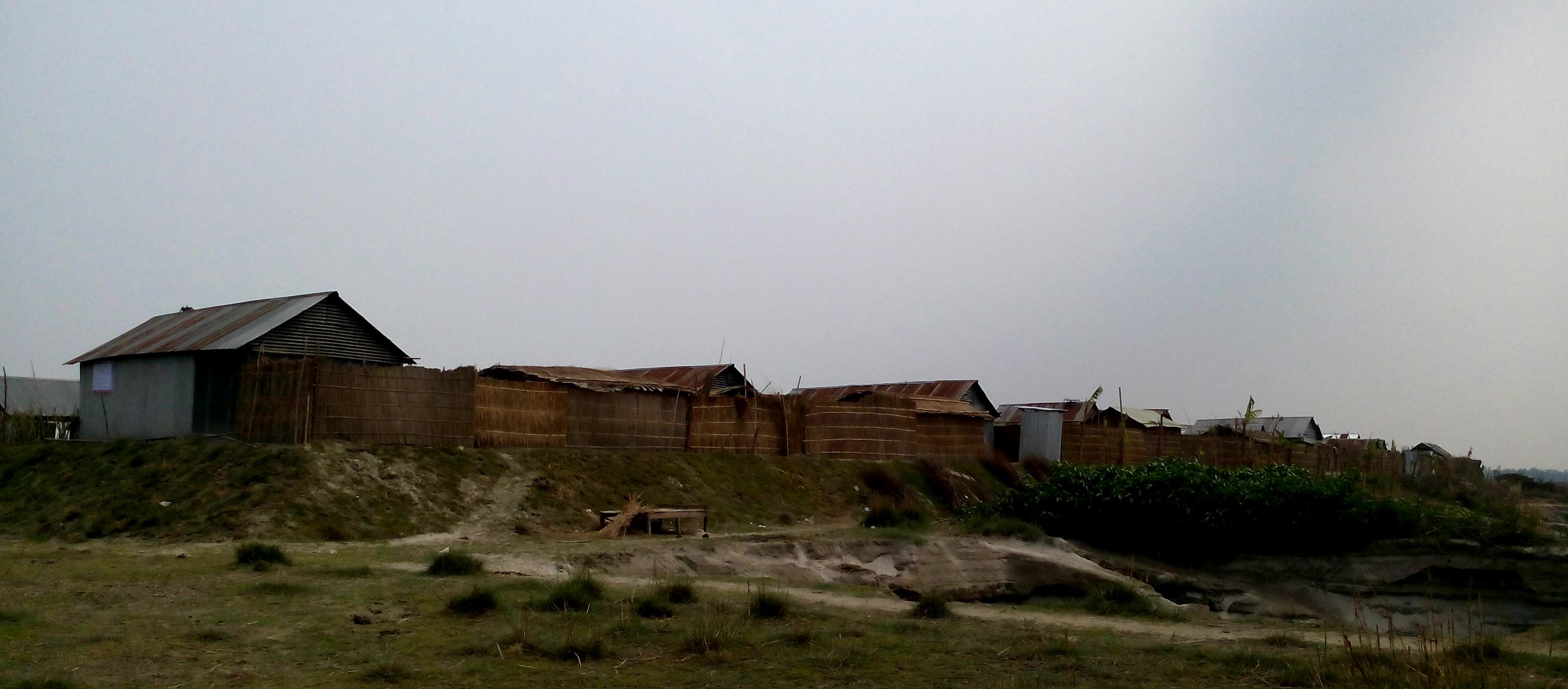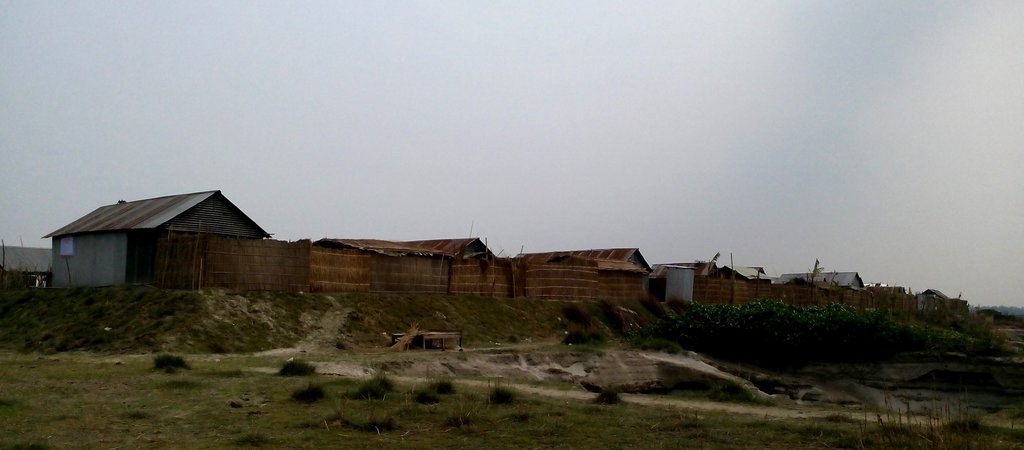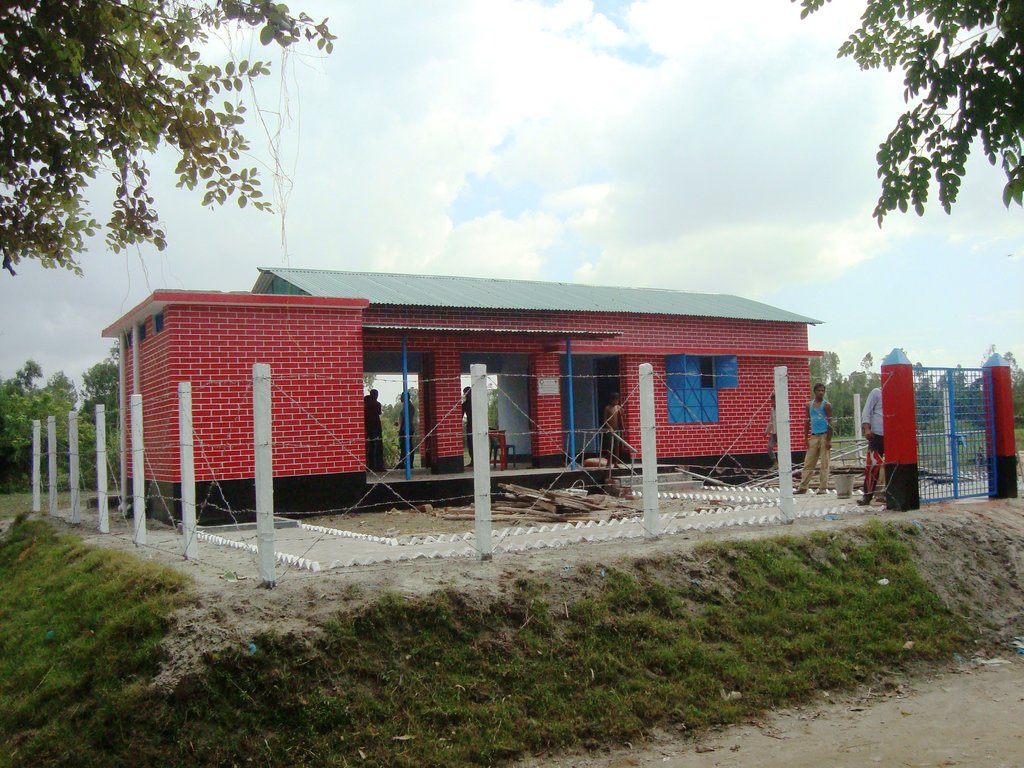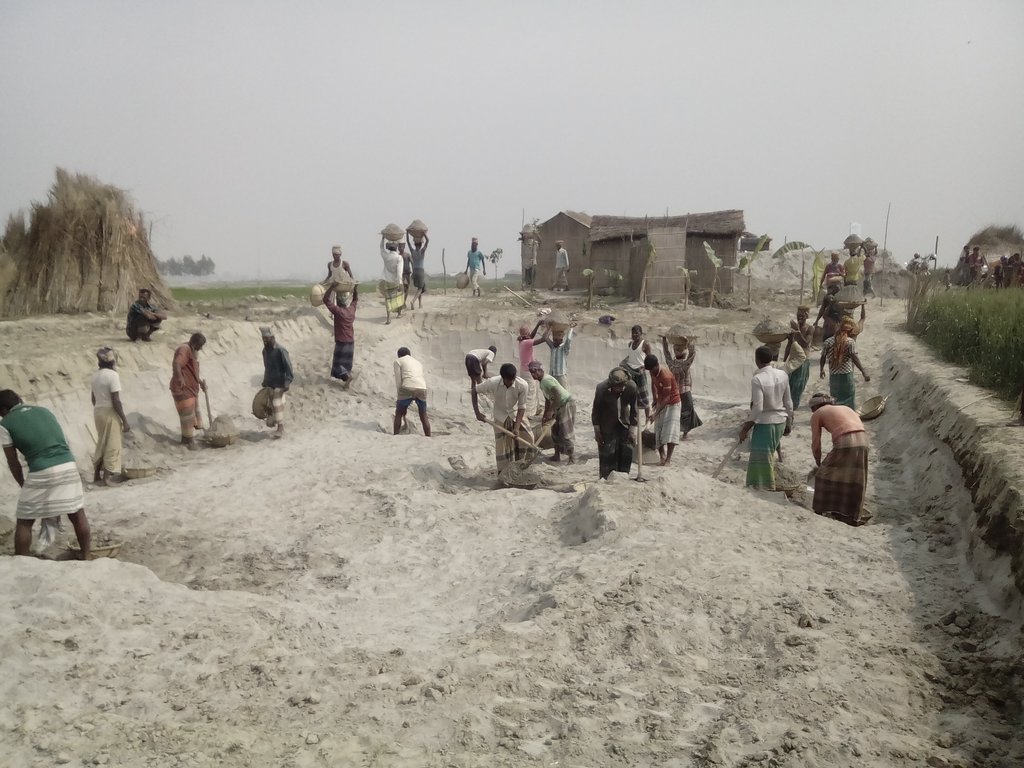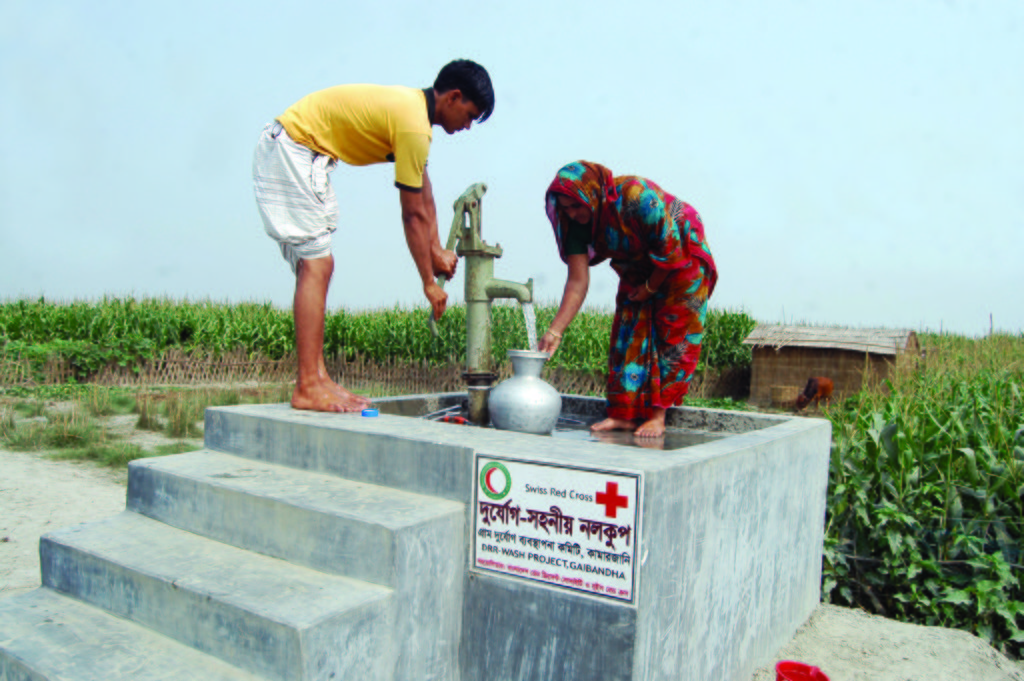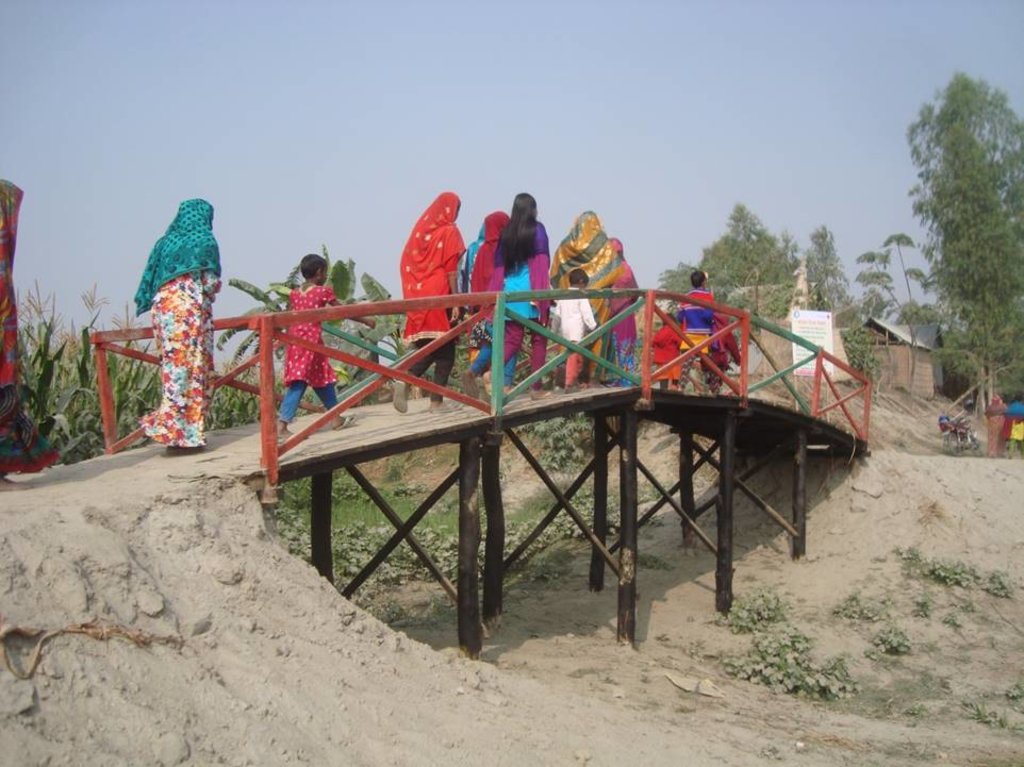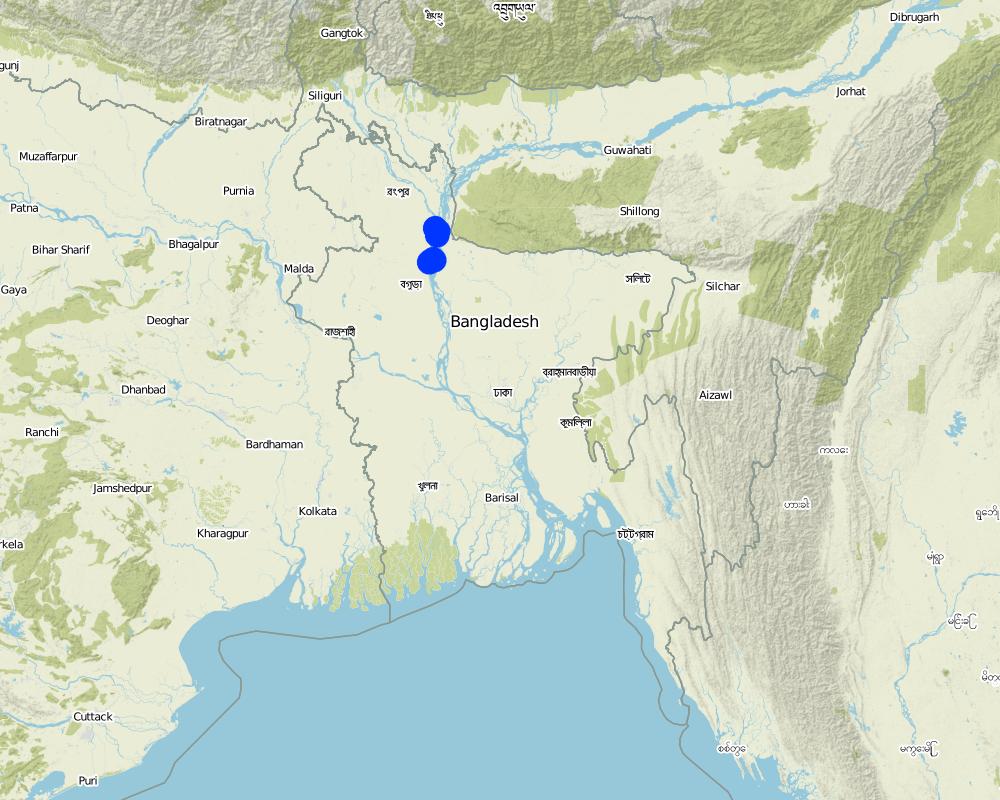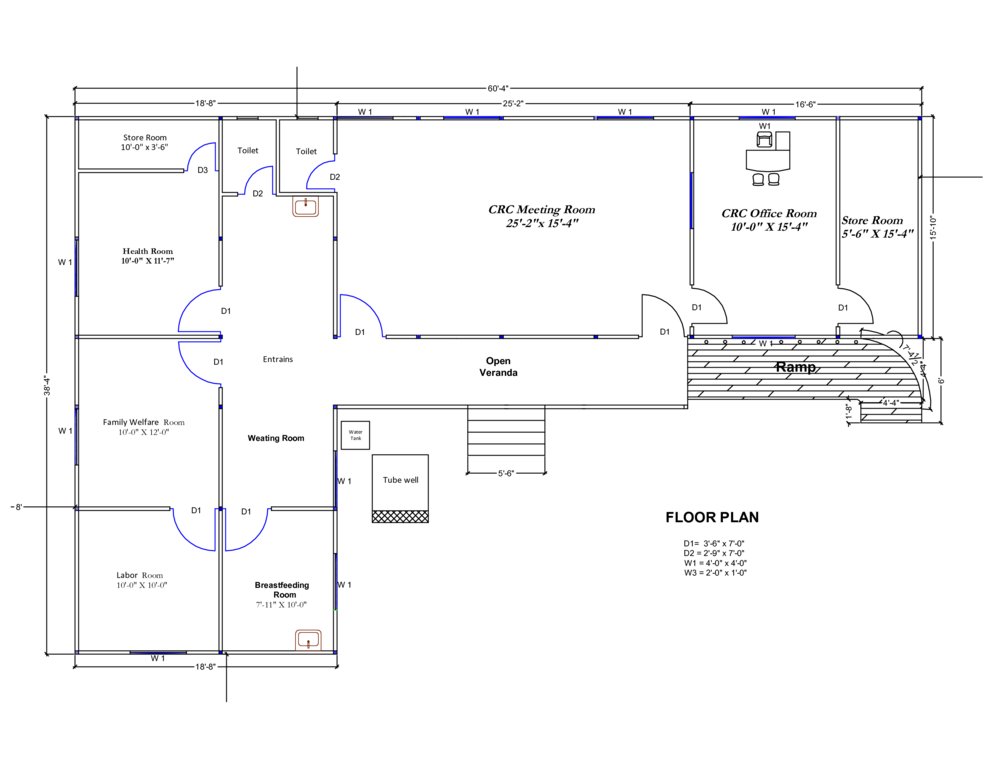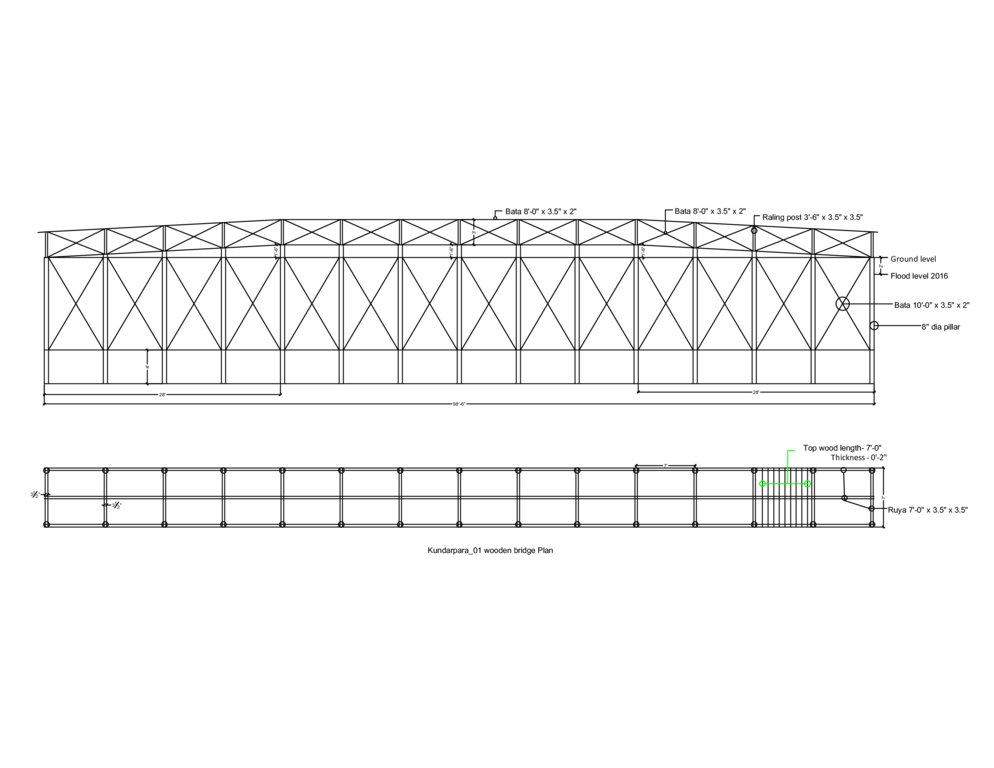Emergency infrastructure including shelter and linked transport infrastructure [Bangladesh]
- Création :
- Mise à jour :
- Compilateur : TUHIN SAMADDAR
- Rédacteur : Anton Jöhr
- Examinateurs : Nicole Harari, Hanspeter Liniger, Alexandra Gavilano
দুর্যোগ সহনশীন অবকাঠামো উন্নয়ন (Durjog-shahonshil abokathamo unnayon)
technologies_664 - Bangladesh
- Résumé complet en PDF
- Résumé complet en PDF pour impression
- Résumé complet dans le navigateur
- Résumé complet (non formaté)
- Emergency infrastructure, shelter and access: 28 mars 2017 (inactive)
- Emergency infrastructure including shelter and linked transport infrastructure: 2 août 2017 (inactive)
- Emergency infrastructure including shelter and linked transport infrastructure: 10 novembre 2017 (inactive)
- Emergency infrastructure including shelter and linked transport infrastructure: 5 mars 2019 (public)
Voir les sections
Développer tout Réduire tout1. Informations générales
1.2 Coordonnées des personnes-ressources et des institutions impliquées dans l'évaluation et la documentation de la Technologie
Personne(s)-ressource(s) clé(s)
Project Staff:
Mustafa Golam
+880 1718770373 / +880 1730799762
pmdrrwash16@gmail.com
Bangladesh Red Crescent Society
Project Manager, DRRWASH Project O⌀ਈce, Shukhsantir Bazar, Dhanghora, Gaibandha, Bangladesh
Bangladesh
Project staff:
Razzak Abdur
+880 1730 799763 / +880 1730 799763
razzak.pe@gmail.com
Bangladesh Red Crescent Society
Project Engineer, DRRWASH Project O⌀ਈce, Shukhsantir Bazar, Dhanghora, Gaibandha, Bangladesh
Bangladesh
Project Staff:
Islam Saiful
+880 1730 799746 / +880 1730 799746
saiful644@gmail.com
Bangladesh Red Crescent Society
Field Officer DRR and Training, DRRWASH Project Office, Shukhsantir Bazar, Dhanghora, Gaibandha, Bangladesh
Bangladesh
Nom du projet qui a facilité la documentation/ l'évaluation de la Technologie (si pertinent)
Book project: where people and their land are safer - A Compendium of Good Practices in Disaster Risk Reduction (DRR) (where people and their land are safer)Nom du ou des institutions qui ont facilité la documentation/ l'évaluation de la Technologie (si pertinent)
Swiss Red Cross (Swiss Red Cross) - Suisse1.3 Conditions relatives à l'utilisation par WOCAT des données documentées
Quand les données ont-elles été compilées (sur le terrain)?
04/10/2016
Le compilateur et la(les) personne(s) ressource(s) acceptent les conditions relatives à l'utilisation par WOCAT des données documentées:
Oui
1.4 Déclaration sur la durabilité de la Technologie décrite
Est-ce que la Technologie décrite ici pose problème par rapport à la dégradation des terres, de telle sorte qu'elle ne peut pas être déclarée comme étant une technologie de gestion durable des terres?
Non
Commentaires:
The technology presented has no direct bearing on land degradation.
1.5 Référence au(x) questionnaire(s) sur les Approches de GDT
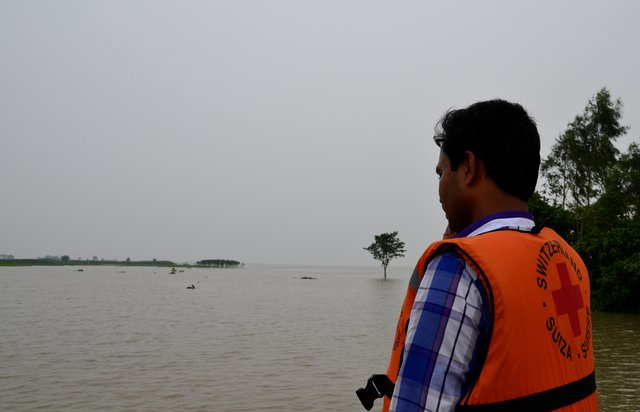
Early Warning Message Dissemination [Bangladesh]
An effective system for dissemination of early warning messages was established among the vulnerable communities in Chars (riverine sandy islands) of Gaibandha district, Bangladesh, in order to strengthen their coping mechanisms and reduce loss and damage caused by floods.
- Compilateur : TUHIN SAMADDAR
2. Description de la Technologie de GDT
2.1 Courte description de la Technologie
Définition de la Technologie:
Emergency infrastructure including shelter and linked transport infrastructure, consists in establishing specific flood shelters (for people and animals) including flood-proof collective water sources and communication infrastructure as well as health and school facilities that may serve at the same time as emergency shelters during floods.
2.2 Description détaillée de la Technologie
Description:
The technology applies to the specific context of the ‘Char’ land in Bangladesh, characterised as riverine sandy Islands along the Jamuna River. More than 80% of the land in the intervention area can be classified as 'Char' and is inhabited by 60% of the population served by the project. Every year, especially during floods, the rivers deposit huge amount of silt sediment that makes the land fertile. At the same time, river action washes away some portion of the 'Char' which at times can be quite large and has a strong impact on people's lives and livelihoods. Before the intervention, people living on 'Char' land depended on their traditional early warning mechanisms and were frequently surprised by floods that destroyed their crops and put their lives in danger. Due to recurring floods, people didn’t have the means to improve their built environment. The 'Char' land is furthermore characterised by its lack of public infrastructure and remoteness to public services.
The technology consists of setting up an emergency infrastructure and ensuring community access to these infrastructures during times of floods. It has to be understood in close interrelation with the approach of setting up an early warning system. The emergency infrastructure includes specific flood shelters (for people and animals), flood-proof collective water sources and sanitation systems, transport infrastructure such as foot bridges and elevated rural roads, as well as flood-proof health and school facilities that also serve as emergency shelters during floods. The flood shelters are built on a raised bed of soil and located at sites selected by the communities that are relatively better protected from flood and river erosion within the 'Chars'. The purpose of the technology is to ensure safety of life and protection of assets during times of emergency and also to mitigate sufferings related to floods. The flood shelter is an elevated plane land which is on an average 220 square feet by size and at least five feet high from the existing ground level. The site is selected by the community and should be connected through an elevated road to the nearest community. This arrangement helps people to get easy access during times of floods. The shelter has collective hygienic latrine facilities and safe water sources. People generally dismantle their housing while evacuating and reinstall it on the flood shelter.
The major activities include facilitating the development of community-led risk reduction action plans and their implementation through community participation and engagement of local governance institutions. This includes maintenance of the built infrastructure as the joint responsibility of the community and the local government. Land use, especially sowing and harvesting, is increasingly linked to flood related forecasting measures which has led to significant adaptation in the timing of farming activities. This coupled with the creation and access to emergency infrastructure allows for a relatively safe and healthy living. The adopted technology and approach has led to adapted livelihoods, reduced health costs and increased income. The technology has furthermore led to mainstreaming disaster risk management in policies and approach of local government institutions. Increasingly the local government’s cash and food for work programmes are targeting establishment and/or reinforcement of emergency infrastructure that can cater to larger population. Increased investments are made especially towards flood shelters and improving communication and access to emergency infrastructure. Since the technology is based on local knowledge and has been developed in consultation with the involved communities, it is generally well accepted with a fair degree of ownership and involvement. However, parts of the region are also prone to river erosion and this has a destructive impact on built infrastructures. The technology does not assure any safeguard against this form of uncertain river action.
2.3 Photos de la Technologie
Remarques générales concernant les photos:
Glimpse of few technologies that served as emergency infrastructure, shelter and access to health and water and sanitation facilities.
2.5 Pays/ région/ lieux où la Technologie a été appliquée et qui sont couverts par cette évaluation
Pays:
Bangladesh
Région/ Etat/ Province:
North-Bengal
Autres spécifications du lieu:
Kamarjani and Mollar Char Union (i.e. municipality) in Sadar Upazila and Haldia Union in Shaghata Upazila of Gaibandha District
Commentaires:
Since the disaster resilient infrastructure set up by the project is installed at a huge number of sites (as indicated in the description above), only a sample of the various emergency infrastructures are indicated on the map above (If needed a comprehensive GPS reading of all infrastructure built by the project can be provided separately).
Map
×2.6 Date de mise en œuvre de la Technologie
Indiquez l'année de mise en œuvre:
2014
Si l'année précise est inconnue, indiquez la date approximative: :
- il y a moins de 10 ans (récemment)
2.7 Introduction de la Technologie
Spécifiez comment la Technologie a été introduite: :
- dans le cadre d'un système traditionnel (> 50 ans)
- par le biais de projets/ d'interventions extérieures
Commentaires (type de projet, etc.) :
The technology has elements of traditional practice (raised plinths for flood protection) and project promoted interventions (emergency shelter and access infrastructure).
3. Classification de la Technologie de GDT
3.1 Principal(aux) objectif(s) de la Technologie
- réduire les risques de catastrophes
- créer un impact économique positif
- créer un impact social positif
3.2 Type(s) actuel(s) d'utilisation des terres, là où la Technologie est appliquée

Terres cultivées
- Cultures annuelles
Principales cultures (vivrières et commerciales):
Paddy, Wheat, maize, jute, chilli, pulse, sweet potato

Implantations, infrastructures
- Habitats, buildings
- Trafic: routes, réseaux ferroviaires
Commentaires:
Despite the lack of public infrastructure and services and being exposed to natural hazards people tend to prefer to live in the 'Char' as it brings significant economic benefits for them: crops grow rapidly and abundantly with significantly lower input costs than on the mainland.
3.3 Informations complémentaires sur l'utilisation des terres
Approvisionnement en eau des terres sur lesquelles est appliquée la Technologie:
- mixte: pluvial-irrigué
Commentaires:
Water supply for the land comprises a mix of rainfed, irrigated and post flooding sources.
Nombre de période de croissance par an: :
- 3
Précisez:
Kharif (monsoon crop), Rabi (winter crop), and Summer/pre-monsoon crop
Densité d'élevage/ chargement (si pertinent):
Cow, buffalo, goat, lamb and donkey are very common in the area. People rear these for cultivation, transportation and for having meat. Every household have at least a pair or more of livestock.
3.4 Groupe de GDT auquel appartient la Technologie
- Emergency infrastructure, shelter and linked transportation infrastructure
3.5 Diffusion de la Technologie
Spécifiez la diffusion de la Technologie:
- répartie uniformément sur une zone
Si la Technologie est uniformément répartie sur une zone, indiquez la superficie couverte approximative:
- 1-10 km2
Commentaires:
Though emergency infrastructures are built at specific sites, their use and benefits are evenly spread over an expanded area.
3.6 Mesures de GDT constituant la Technologie

structures physiques
- S9: Abris pour plantes et animaux
- S11: Autres

modes de gestion
- M4: Changement majeur dans le calendrier des activités
Commentaires:
In addition to the structural and management measures described above, the technology involves additional elements such as flood-proof collective water supply and sanitation systems and communication infrastructure.
3.7 Principaux types de dégradation des terres traités par la Technologie

érosion hydrique des sols
- Wr: érosion des berges
- Wo: effets hors-site de la dégradation
Commentaires:
N/A
3.8 Prévention, réduction de la dégradation ou réhabilitation des terres dégradées
Spécifiez l'objectif de la Technologie au regard de la dégradation des terres:
- s'adapter à la dégradation des terres
Commentaires:
NA
4. Spécifications techniques, activités, intrants et coûts de mise en œuvre
4.1 Dessin technique de la Technologie
4.2 Spécification/ explications techniques du dessin technique
The built structural mitigation options have following technical specification:
1. Flood shelter: Dimension: Length-220' x Width-220' x Height- 5.5', Slope: 1:1.5, Capacity: 350 families, Construction material used: soil and turfing (grass)
2. Raised school compound: Dimension: Length-112' x Width-75' x Height- 5.5', Slope: 1:1.5, Capacity: 540 person, Construction material used: soil and turfing (grass)
3. Community Resource Centre and Community Clinic (CRC-CC): Dimension: Length-60' x Width-38' x Height- 5.6', Slope: 1:1.5, Capacity: 1500 families from 5 villages, Construction material used: soil and grass plantation, bricks, sand, cement, rod, iron angel and CGI sheet.
4. Disaster resilient tube well: Dimension: Length-5' 10" x Width-5' x Height- 3', Boring: 100 feet, Capacity: 200 families, Construction material used: bricks, sand, cement, rod, tube well head, pvc pipe, cylinder, piston rod etc. Vertical intervals: 2 in each village.
5. Concrete platform for (existing) tube well: Dimension: Length-4' 10" x Width-4' x Height- 1', Capacity: 100 families, Construction material used: bricks, sand, cement, pvc pipe
6. Wooden bridge: Dimension: Length-99' x Width-7' x Height- 12', Slope: 1:1.5, Capacity: 900 families approximately, Construction material used: wood, nails, tar, soil and grass plantation
7. Road construction/repair: Dimension: Length-925' x Width-12' x Height- 3' (from existing level), Slope: 1:1.5, Capacity: 3 villages (approx:1000 families), Construction material used: soil and turfing (grass).
4.3 Informations générales sur le calcul des intrants et des coûts
Spécifiez la manière dont les coûts et les intrants ont été calculés:
- par entité de la Technologie
Précisez l'unité:
flood shelter, raised school compound, disaster resilient tube well, concrete platform for (existing) tube well, wooden bridge, road construction/repair
Spécifiez le volume, la longueur, etc. (si pertinent):
road: per meter
autre/ monnaie nationale (précisez):
Bangladeshi Taka (BDT)
Indiquer le taux de change du dollars en monnaie locale (si pertinent): 1 USD= :
79,0
Indiquez le coût salarial moyen de la main d'œuvre par jour:
350 BDT
4.4 Activités de mise en place/ d'établissement
| Activité | Type de mesures | Calendrier | |
|---|---|---|---|
| 1. | Construction of Flood Shelter | Structurel | During dry season |
| 2. | Raising school compound | Structurel | During dry season |
| 3. | Construction of Community Resource Center (CRC) | Structurel | During dry season |
| 4. | Installation of disaster resilient tube well | Structurel | During dry season |
| 5. | Construction of concrete platform for (existing) tube well | Structurel | During dry season |
| 6. | Construction of wooden bridge | Structurel | During dry season |
| 7. | Road construction above flood level | Structurel | During dry season |
Commentaires:
All activities are structural in nature and can be undertaken efficiently only in dry season.
4.5 Coûts et intrants nécessaires à la mise en place
| Spécifiez les intrants | Unité | Quantité | Coûts par unité | Coût total par intrant | % du coût supporté par les exploitants des terres | |
|---|---|---|---|---|---|---|
| Main d'œuvre | Flood shelter: earth work | m3 | 8000,0 | 64,0 | 512000,0 | 10,0 |
| Main d'œuvre | CRC: earth work | m3 | 53,0 | 138,0 | 7314,0 | 10,0 |
| Main d'œuvre | CRC: sand filling | m3 | 302,0 | 99,0 | 29898,0 | 10,0 |
| Main d'œuvre | Raised school compound: earth work | m3 | 1790,0 | 64,0 | 114560,0 | 10,0 |
| Matériel végétal | Flood shelter: grass plantation (turfing) | m2 | 4620,0 | 13,0 | 60060,0 | 10,0 |
| Matériel végétal | Flood shelter: seedlings | piece | 20,0 | 53,0 | 1060,0 | 10,0 |
| Matériel végétal | CRC: grass plantation (turfing) | m2 | 3890,0 | 13,0 | 50570,0 | 10,0 |
| Matériel végétal | CRC: seedlings | piece | 50,0 | 53,0 | 2650,0 | 10,0 |
| Matériel végétal | Raised school compound: grass plantation (turfing) | m2 | 1390,0 | 13,0 | 18070,0 | 10,0 |
| Matériel végétal | Raised school compound: seedlings | piece | 40,0 | 53,0 | 2120,0 | 10,0 |
| Matériaux de construction | CRC: roof truss | kg | 4375,0 | 100,0 | 437500,0 | |
| Matériaux de construction | CRC: grill and iron work | m2 | 88,0 | 2091,0 | 184008,0 | |
| Matériaux de construction | CRC: gypsum board | m2 | 478,0 | 922,0 | 440716,0 | |
| Matériaux de construction | CRC: RCC work | m3 | 2,9 | 19557,0 | 56715,3 | |
| Matériaux de construction | CRC: deformed bar | kg | 397,0 | 85,0 | 33745,0 | |
| Matériaux de construction | CRC: boundary fencing | m2 | 184,0 | 440,0 | 80960,0 | |
| Matériaux de construction | CRC: brick work | m3 | 44,0 | 5515,0 | 242660,0 | |
| Autre | CRC: electric ware and solar panel | lumpsum | 1,0 | 73000,0 | 73000,0 | |
| Autre | CRC: water supply | lumpusm | 1,0 | 66150,0 | 66150,0 | |
| Autre | CRC: transportation | lumpsum | 1,0 | 89000,0 | 89000,0 | |
| Coût total de mise en place de la Technologie | 2502756,3 | |||||
Si le coût n'est pas pris en charge à 100% par l'exploitant des terres, indiquez qui a financé le coût restant:
10% of all construction cost (except community resource center) is borne by the user. Another 15% is provided by the local government bodies. The remaining 75% is subsidised by the project.
Commentaires:
Defining costs of establishment is bit tricky as the measures differ in size and number, costs vary from one village to another depending on the geographical location. However, average costs of the measures further to those highligted in the table are given below:
Disaster resilient tube well: labour (mason) 3'000, equipment (drilling charge) 1800, construction material (bricks, cement, sand, iron rod, PVC pipe, cylinder, GI pipe, tubewell head) 23'250, transportation 2'650, total unit costs (BDT) 30'700
Concrete platform for (existing) tube well : labour (mason) 600, construction material (bricks, cement, sand) 2'450, other (Transportation, waste water disposal) 1650, total unit costs (BDT) 4'700
Wooden bridge: labour (mason, mason assitant, painting assistant, earthwork) 30'000, plant material (grass plantation) 12'500, equipment (painting brush etc.) 1'000, construction material (timber, nails, tar, tarpin oil, paint) 260'000, Transportation 30'000, total unit costs (BDT) 333'500
Road construction/repair: labour (earthwork) 102'500, plant material (grass plantation/turfing), 12'500, total unit costs (BDT) 115'000
4.6 Activités d'entretien/ récurrentes
| Activité | Type de mesures | Calendrier/ fréquence | |
|---|---|---|---|
| 1. | Construction of Flood Shelter | Structurel | During dry season |
| 2. | Raising school compound | Structurel | During dry season |
| 3. | Construction of Community Resource Center (CRC) | Structurel | During dry season |
| 4. | Installation of disaster resilient tube well | Structurel | During dry season |
| 5. | Construction of concrete platform ror (existing) tube well | Structurel | During dry season |
| 6. | Construction of wooden bridge | Structurel | During dry season |
| 7. | Road construction above flood level | Structurel | During dry season |
Commentaires:
Due to the softness of the sandy soil and the annual inundation, every measure requires considerable maintenance. The flooding generally washes out sands and decays the foundation of the structure. If maintenance is done in regular intervals, the entire structure remains functional. Also, grass needs to be frequently replanted as it dries up during the dry season.
The users and the local government (Union Disaster Management Committee) are mainly responsible for maintenance of all built assets and structures including the Community Resource Center. The relevant operation/repair and maintenance training has been provided by the project.. Maintenance manuals and guidelines have been developed and disseminated. Also, repair and maintenance equipment has been provided to cadre of users/caretakers trained in repair/maintenance work.
4.7 Coûts et intrants nécessaires aux activités d'entretien/ récurrentes (par an)
| Spécifiez les intrants | Unité | Quantité | Coûts par unité | Coût total par intrant | % du coût supporté par les exploitants des terres | |
|---|---|---|---|---|---|---|
| Main d'œuvre | Earthwork | m3 | 80,0 | 63,0 | 5040,0 | 10,0 |
| Main d'œuvre | Sand bag filling | piece | 50,0 | 15,0 | 750,0 | 10,0 |
| Main d'œuvre | Pipe fitting | piece | 2,0 | 300,0 | 600,0 | 10,0 |
| Main d'œuvre | Mason | lumpsum | 1,0 | 500,0 | 500,0 | 10,0 |
| Matériel végétal | Grass plantation (turfing) | m2 | 85,0 | 13,0 | 1105,0 | 10,0 |
| Matériel végétal | Seedlings | piece | 15,0 | 53,0 | 795,0 | 10,0 |
| Matériaux de construction | Plastic bag | piece | 50,0 | 10,0 | 500,0 | 10,0 |
| Matériaux de construction | PVC pipe | m | 15,0 | 120,0 | 1800,0 | 10,0 |
| Matériaux de construction | Polythene pipe | kg | 5,0 | 160,0 | 800,0 | 10,0 |
| Matériaux de construction | Ciment | bag | 0,5 | 540,0 | 270,0 | 10,0 |
| Matériaux de construction | Sand | ft3 | 5,0 | 18,0 | 90,0 | 10,0 |
| Matériaux de construction | Caping socket | piece | 2,0 | 35,0 | 70,0 | 10,0 |
| Matériaux de construction | Tape etc. | lumpsum | 1,0 | 250,0 | 250,0 | 10,0 |
| Coût total d'entretien de la Technologie | 12570,0 | |||||
Si le coût n'est pas pris en charge à 100% par l'exploitant des terres, indiquez qui a financé le coût restant:
Maintenance costs are to date (2017) distributed as construction (10% by the users, 15% by the local government). A cost transfer scheme to the users and local government for maintenance is developped to be applied in the follow-up phase.
Commentaires:
Again, defining costs of maintenance is also not easy as the measures differ in size and number. Average costs of the measures, further to those for flood shelter including disaster resilient tube well as highligted in the table, are given below:
Raised school compound: labour (earth work and sand bag filling) 7'800, plant material (grass plantation) 1'000, construction material (plastic bag, rope) 500, total unit maintenance costs (BDT) 9'300
Community resource Center (CRC): labour 1'200, plant material (grass plantation, seedlings) 10'500, Transportation 1'000, total unit maintenance costs (BDT) 12'700
Concrete platform for (existing) tube well : labour (mason) 500, construction material (bricks, cement, sand) 600, total unit maintenance costs (BDT) 1'100
Wooden bridge: labour (earthwork) 2'500, plant material (grass plantation) 3'000, construction material (plastic bag, rope) 2'000, total unit maintenance costs (BDT) 7'500
Road construction/repair: labour (earthwork) 10'000, plant material (grass plantation/turfing), 1'500, construction material (plastic bag, rope) 500, total unit maintenance costs (BDT) 12'000
4.8 Facteurs les plus importants affectant les coûts
Décrivez les facteurs les plus importants affectant les coûts :
Transportation of raw material from the mainland to the sites on the 'Char' Islands varies across seasons. In the dry season it is much higher compared to monsoon as the delivery of material is easier in the latter due to extended river outreach.
5. Environnement naturel et humain
5.1 Climat
Précipitations annuelles
- < 250 mm
- 251-500 mm
- 501-750 mm
- 751-1000 mm
- 1001-1500 mm
- 1501-2000 mm
- 2001-3000 mm
- 3001-4000 mm
- > 4000 mm
Spécifiez la pluviométrie moyenne annuelle (si connue), en mm:
2134,80
Spécifications/ commentaires sur les précipitations:
Rainy season: April- October
Occurrence of heavy rain: June-July
Length of dry period: November-March
Indiquez le nom de la station météorologique de référence considérée:
18 Gaibandha Sadar, Gaibandha
Zone agro-climatique
- humide
Tropical humid climatic zone.
Temperature: maximum 33.5°C, minimum 10.5°C
5.2 Topographie
Pentes moyennes:
- plat (0-2 %)
- faible (3-5%)
- modéré (6-10%)
- onduleux (11-15%)
- vallonné (16-30%)
- raide (31-60%)
- très raide (>60%)
Reliefs:
- plateaux/ plaines
- crêtes
- flancs/ pentes de montagne
- flancs/ pentes de colline
- piémonts/ glacis (bas de pente)
- fonds de vallée/bas-fonds
Zones altitudinales:
- 0-100 m
- 101-500 m
- 501-1000 m
- 1001-1500 m
- 1501-2000 m
- 2001-2500 m
- 2501-3000 m
- 3001-4000 m
- > 4000 m
Indiquez si la Technologie est spécifiquement appliquée dans des:
- non pertinent
Commentaires et précisions supplémentaires sur la topographie:
Information on altitudinal zone collected from the website: www.getamap.net
5.3 Sols
Profondeur moyenne du sol:
- très superficiel (0-20 cm)
- superficiel (21-50 cm)
- modérément profond (51-80 cm)
- profond (81-120 cm)
- très profond (>120 cm)
Texture du sol (de la couche arable):
- moyen (limoneux)
- fin/ lourd (argile)
Texture du sol (> 20 cm sous la surface):
- grossier/ léger (sablonneux)
- moyen (limoneux)
Matière organique de la couche arable:
- moyen (1-3%)
Si disponible, joignez une description complète du sol ou précisez les informations disponibles, par ex., type de sol, pH/ acidité du sol, capacité d'échange cationique, azote, salinité, etc.
N/A
5.4 Disponibilité et qualité de l'eau
Profondeur estimée de l’eau dans le sol:
5-50 m
Disponibilité de l’eau de surface:
moyenne
Qualité de l’eau (non traitée):
eau potable
La salinité de l'eau est-elle un problème? :
Non
La zone est-elle inondée?
Oui
Régularité:
fréquemment
Commentaires et précisions supplémentaires sur la qualité et la quantité d'eau:
In the dry season water crisis occurs. Open defecation and use of pesticide in farming are key pollutants of water sources.
5.5 Biodiversité
Diversité des espèces:
- moyenne
Diversité des habitats:
- moyenne
Commentaires et précisions supplémentaires sur la biodiversité:
Biodiversity can be rated as moderate or medium both in terms of species and habitat. It is stable and and often self generating.
5.6 Caractéristiques des exploitants des terres appliquant la Technologie
Sédentaire ou nomade:
- Sédentaire
- Semi-nomade
Orientation du système de production:
- mixte (de subsistance/ commercial)
Revenus hors exploitation:
- moins de 10% de tous les revenus
Niveau relatif de richesse:
- pauvre
Individus ou groupes:
- individu/ ménage
- groupe/ communauté
Niveau de mécanisation:
- traction animale
- mécanisé/ motorisé
Genre:
- femmes
- hommes
Age des exploitants des terres:
- jeunes
- personnes d'âge moyen
Indiquez toute autre caractéristique pertinente des exploitants des terres:
N/A
5.7 Superficie moyenne des terres détenues ou louées par les exploitants appliquant la Technologie
- < 0,5 ha
- 0,5-1 ha
- 1-2 ha
- 2-5 ha
- 5-15 ha
- 15-50 ha
- 50-100 ha
- 100-500 ha
- 500-1 000 ha
- 1 000-10 000 ha
- > 10 000 ha
Cette superficie est-elle considérée comme de petite, moyenne ou grande dimension (en se référant au contexte local)?
- petite dimension
Commentaires:
People living in Chars have small landholding which often produces enough for subsistence and, in some cases, for market purposes.
5.8 Propriété foncière, droits d’utilisation des terres et de l'eau
Propriété foncière:
- état
- individu, sans titre de propriété
Droits d’utilisation des terres:
- accès libre (non organisé)
- loué
Droits d’utilisation de l’eau:
- communautaire (organisé)
- individuel
Commentaires:
Land ownership is quite complex as Chars by nature are unstable habitats. In principle land is owned by state but in most cases the politician - musclemen nexus exercises real control. This results in leasing and renting of land which is the predominant form of land ownership in Chars.
5.9 Accès aux services et aux infrastructures
santé:
- pauvre
- modéré
- bonne
éducation:
- pauvre
- modéré
- bonne
assistance technique:
- pauvre
- modéré
- bonne
emploi (par ex. hors exploitation):
- pauvre
- modéré
- bonne
marchés:
- pauvre
- modéré
- bonne
énergie:
- pauvre
- modéré
- bonne
routes et transports:
- pauvre
- modéré
- bonne
eau potable et assainissement:
- pauvre
- modéré
- bonne
services financiers:
- pauvre
- modéré
- bonne
Access to mobile phone and internet:
- pauvre
- modéré
- bonne
6. Impacts et conclusions
6.1 Impacts sur site que la Technologie a montrés
Impacts socio-économiques
Production
production agricole
Quantité avant la GDT:
3600 kg/hectare (maize)
Quantité après la GDT:
11400 kg/hectare (maize)
Commentaires/ spécifiez:
Crop production has increased thrice due to stability of household which has led to stable use of land in the chars.
Disponibilité et qualité de l'eau
disponibilité de l'eau potable
Quantité avant la GDT:
No safe drinking water source was available
Quantité après la GDT:
More than 40% water source are safe
Commentaires/ spécifiez:
Collective water supply systems have groundwater sources and thus no treatment is needed. Further, aspects of availability, easy access and sustainable availability of sufficient water of acceptable quality are well considered. Families can access 10 litres per capita per day (LPCD) during emergencies (which is in line with Sphere standards) and during normal times 40 LPCD is what families can collect from these water sources. All such water sources are within a distance of 50 metres from the settlement as per Bangladesh standards.
qualité de l'eau potable
Quantité avant la GDT:
Reliable data not available
Quantité après la GDT:
All households have access to safe drinking water as per govt. standard for rural areas
Commentaires/ spécifiez:
The collective water infrastructure built by the project ensures fulfillment of minimum standards set by the govt for safe drinking water.
Revenus et coûts
revenus agricoles
Quantité avant la GDT:
25% families had farm income
Quantité après la GDT:
95% families have farm income
Commentaires/ spécifiez:
Cattle and poultries are safe during disaster
Impacts socioculturels
situation sanitaire
Commentaires/ spécifiez:
The disaster mitigation measures has significantly improved the health situation of the target population.
institutions communautaires
Quantité avant la GDT:
Few credit groups in intervention villages
Quantité après la GDT:
30 community based organisatons (i.e. village disaster management committees) and 3 Local Government Committees (Union disaster management committee)
Commentaires/ spécifiez:
Community based organisations and government mandated institutions have been promoted through project initiatives.
institutions nationales
Commentaires/ spécifiez:
CRC is also being used for UDMC office which is an important committee of union parishad.
apaisement des conflits
Quantité avant la GDT:
Widespread
Quantité après la GDT:
Rare
Commentaires/ spécifiez:
Conflict sensitive approach has significantly reduced the incidence of conflicts.
Impacts écologiques
Cycle de l'eau/ ruissellement
quantité d'eau
Quantité avant la GDT:
Data not available
Quantité après la GDT:
Same
Commentaires/ spécifiez:
The disaster resilient tube well ensures year round drinking water.
Réduction des risques de catastrophe et des risques climatiques
impacts des inondations
Quantité avant la GDT:
95% families were effected from flood
Quantité après la GDT:
47% families are affected from flood
Commentaires/ spécifiez:
The above figures are from 2016 when Bangladesh experienced one of the worst floods in recent times.
6.2 Impacts hors site que la Technologie a montrés
Commentaires concernant l'évaluation des impacts:
N/A
6.3 Exposition et sensibilité de la Technologie aux changements progressifs et aux évènements extrêmes/catastrophes liés au climat (telles que perçues par les exploitants des terres)
Extrêmes climatiques (catastrophes)
Catastrophes météorologiques
| Comment la Technologie fait-elle face à cela? | |
|---|---|
| pluie torrentielle locale | modérément |
| tempête de sable/ de poussière locale | bien |
| tempête de vent locale | bien |
Catastrophes climatiques
| Comment la Technologie fait-elle face à cela? | |
|---|---|
| canicule | bien |
| vague de froid | bien |
| sécheresse | bien |
Catastrophes hydrologiques
| Comment la Technologie fait-elle face à cela? | |
|---|---|
| inondation générale (rivière) | bien |
| glissement de terrain | pas bien |
Commentaires:
In some cases the appropriate answer would have been "not applicable" but since this is not there, we have selected "well".
6.4 Analyse coûts-bénéfices
Quels sont les bénéfices comparativement aux coûts de mise en place (du point de vue des exploitants des terres)?
Rentabilité à court terme:
très positive
Rentabilité à long terme:
positive
Quels sont les bénéfices comparativement aux coûts d'entretien récurrents (du point de vue des exploitants des terres)?
Rentabilité à court terme:
positive
Rentabilité à long terme:
légèrement positive
Commentaires:
The limited returns that have been generated by the project is highly valued by the users from a cost - benefit perspective; especially when they understand that the project is not directly linked to land management practices. Thus, the indirect benefits are perceived to have high value.
6.5 Adoption de la Technologie
- plus de 50%
Si disponible, quantifiez (nombre de ménages et/ou superficie couverte):
Out of a total of 8828 HHs targeted by the project, around five thousand HHs in three union have benefitted from the implementation of the technology.
Parmi tous ceux qui ont adopté la Technologie, combien d'entre eux l'ont fait spontanément, à savoir sans recevoir aucune incitation matérielle ou aucun paiement?
- 0-10%
6.6 Adaptation
La Technologie a-t-elle été récemment modifiée pour s'adapter à l'évolution des conditions?
Oui
Si oui, indiquez à quel changement la Technologie s'est adaptée:
- la disponibilité de la main-d'œuvre (par ex., en raison de migrations)
Spécifiez l'adaptation de la Technologie (conception, matériaux/ espèces, etc.):
Dredging machine has been used for building some emergency infrastructure at few sites due to unavailability of labour at the time of construction.
6.7 Points forts/ avantages/ possibilités de la Technologie
| Points forts/ avantages/ possibilités du point de vue de l'exploitant des terres |
|---|
|
Emergency structures are collectively owned and have a multipurpose use; in 'normal' (non-emergency) times they are used for other purpose than safety and protection which includes community meeting, workshop and training |
| Expanded opportunities of communication during flood |
| Points forts/ avantages/ possibilités du point de vue du compilateur ou d'une autre personne ressource clé |
|---|
|
Community is aware and driven to implement flood preparedness and risk reduction measures on its own |
| Appropriate measures can significantly change people's mindset and behaviour |
6.8 Faiblesses/ inconvénients/ risques de la Technologie et moyens de les surmonter
| Faiblesses/ inconvénients/ risques du point de vue de l’exploitant des terres | Comment peuvent-ils être surmontés? |
|---|---|
|
River erosion threatens built structures |
Careful site selection for construction work through in depth discussion with community people supported by scientific analysis |
| High investment needed for building physical structures (e.g. CRC building) in the char which the local government and community find difficult to finance without external support. | Install portable semi-permanent structures in the char; Lobby for greater decentralisation of finances to local government |
| Faiblesses/ inconvénients/ risques du point de vue du compilateur ou d'une autre personne ressource clé | Comment peuvent-ils être surmontés? |
|---|---|
|
|
7. Références et liens
7.1 Méthodes/ sources d'information
- interviews/entretiens avec les exploitants des terres
3
- interviews/ entretiens avec les spécialistes/ experts de GDT
4
- compilation à partir de rapports et d'autres documents existants
2
7.2 Références des publications disponibles
Titre, auteur, année, ISBN:
Latrine and Tube well maintenance manual, SRC-BDRCS-DASCOH
Disponible à partir d'où? Coût?
SRC
Liens et modules
Développer tout Réduire toutLiens

Early Warning Message Dissemination [Bangladesh]
An effective system for dissemination of early warning messages was established among the vulnerable communities in Chars (riverine sandy islands) of Gaibandha district, Bangladesh, in order to strengthen their coping mechanisms and reduce loss and damage caused by floods.
- Compilateur : TUHIN SAMADDAR
Modules
Aucun module trouvé


